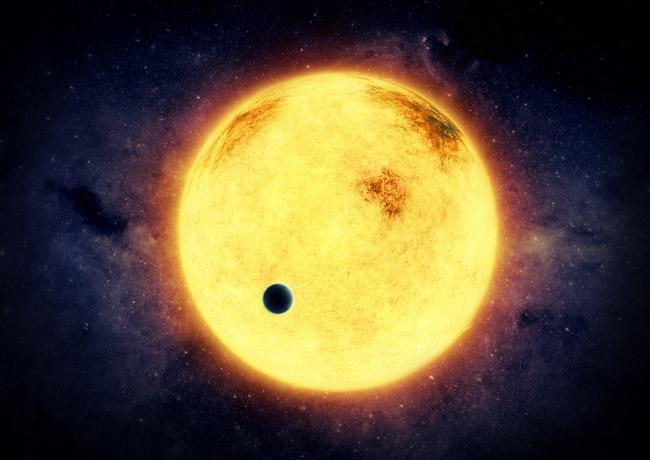Scientists Announce Orbital Tilt Measurements in Youngest Planetary Star System Ever

Cambridge, MA -
Scientists at the Center for Astrophysics | Harvard & Smithsonian have, for the first time, measured the orbital tilt of an exoplanet younger than 45 million years. While observing DS Tuc Ab—a recently discovered, young, Neptune-sized planet with an orbital period of eight days—scientists developed new modeling techniques to take stellar obliquity measurements and demographic information about the planet.
"The discovery of DS Tuc Ab in 2019 gave us a unique opportunity to take measurements of a planet around a very young star very soon after the planet's formation," said George Zhou, astronomer at CfA. "This planet is only 40 million years old; by comparison, our Solar System is 5 billion years old. We've never had a planet so young that we can study in this fashion before."
After a few billion years have passed planets change, making it more difficult for scientists to answer questions about the formation, life and maturation of planets. "A lot of things can happen between when a planet is formed and when we see them. The vast majority of planets we find are already mature and we don't know what they were like when they were young," said Zhou. "We've already learned that unlike other planets, DS Tuc Ab didn't pinball, or get flung into, its star system. That opens up many other possibilities for other similar, young exoplanets, and may help us to better understand older planets we already know about."
According to Zhou, the host star, DS Tuc A, was covered up to 40% in star spots, making observation and analysis of the young planet difficult. "Young stars don’t behave nicely, and this is a really young star," said Zhou. "It is very active, and the star spots initially made it difficult to take accurate data since the planet was crossing our line of sight across the face of the star."
To combat these challenges and characterize the planet and star system, scientists developed a new technique for simultaneously modeling the many different factors involved, allowing them to better track the young planet in its orbit.
"We had to infer how many spots there were, their size, and their color. Each time we'd add a star spot, we'd check its consistency with everything we already knew about the planet," said David Latham, CfA. "As TESS finds more young stars like DS Tuc A, where the shadow of a transiting planet is hidden by variations due to star spots, this new technique for uncovering the signal of the planet will lead to a better understanding of the early history of planets in their infancy."
DS Tuc Ab was first discovered by scientists at Dartmouth, CfA, and MIT, using data from NASA's TESS mission in 2019. "We were excited when we first saw this planet's signal," said Dr. Elisabeth Newton, Assistant Professor, Dartmouth. "The star is bright and young, and we knew it would offer exciting possibilities for in-depth investigations like this one." A parallel discovery paper was published by scientists at INAF—the National Institute for Astrophysics in Italy—the same year.
Zhou and scientists from the CfA began observing the planet in August 2019, using the Planet Finder Spectrograph on the Magellan Telescope in Chile. Results from the study will be published in the Astrophysical Journal Letters. A companion study from Benjamin Montet (U. New South Wales) et al. will be published in the Astronomical Journal and is available online.
About Center for Astrophysics | Harvard & Smithsonian
Headquartered in Cambridge, Mass., the Center for Astrophysics | Harvard & Smithsonian (CfA) is a collaboration between the Smithsonian Astrophysical Observatory and the Harvard College Observatory. CfA scientists, organized into six research divisions, study the origin, evolution and ultimate fate of the universe.
For more information, contact:
Amy Oliver
Public Affairs
Center for Astrophysics | Harvard & Smithsonian
Fred Lawrence Whipple Observatory
520-879-4406
amy.oliver@cfa.harvard.edu